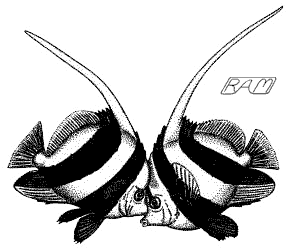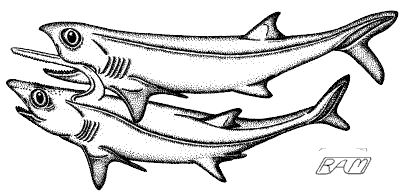A Golden Age of Sharks
Sharks have undergone a lot of evolutionary experimentation since their earliest beginnings. Over hundreds of millions of years, sharks were tested by a mercurial and often violently changeable environment. As a group, sharks survived these vicissitudes and demonstrated the remarkable durability of their basic design. But, just like other creatures, individual lineages of sharks had to adapt to changes in their local environment or perish. Sudden changes in environmental conditions — such as sea level or ocean circulation — often result in mass extinctions, eliminating those designs that cannot cope with the new challenges thus imposed. Such large-scale die-offs often vacate ecological niches, opening them to new contestants. Each time their environment was radically altered, shark lineages responded with a spectacular flowering of diversity, enabling them to expand into new niches. Such explosive increases in variety are termed "adaptive radiations". Not all of the lineages created by such radiations were successful, but — as a group — sharks endured and survived. Over their long evolutionary career, sharks have undergone two major adaptive radiations and survived at least five mass extinctions that many other creatures did not.
The first major shark radiation occurred during the Carboniferous Period, 360 to 286 million years ago. The Carboniferous (meaning "coal forming") gets its name from the thick layer of plant matter, laid down when shallow seas drowned northern continents, that were later squeezed into coal. On land, horsetails, conifers, and club mosses provided a lush landscape for giant dragonflies to buzz through on wings spanning up to 28 inches (70 centimetres). Snails, centipedes, and scorpions crawled over the verdant forest floor. A variety of sturdy-limbed amphibians clambered laboriously through the leaf litter. In freshwater lakes swam lungfishes and xenacanth sharks (descendants of Antarctilamna that persisted in freshwater environments until the early Triassic Period, about 220 million years ago). In the sea, corals, bryozoans, crinoids, and molluscs flourished. But, with the exception of acanthodians, few fishes swam in early Carboniferous seas. The fossil record indicates that more than 75% of fish groups alive during the late Devonian died out before the beginning of the Carboniferous. The placoderms — a once dominant group of armored fishes — survived this extinction event, but at greatly reduced diversity and abundance.
Stethacanthus
The misfortune of the placoderms presented a splendid opportunity for sharks in general and one group in particular: the stethacanthids. Perhaps in response to the ecological niches vacated by the placoderms, the stethacanthids exploded into a riot of bizarre forms and lifestyles. It was a kind of stethacanthid Mardi Gras — complete with outrageously unwieldy headgear and strange but fascinating rituals. One of the most outlandish of these sharks was Stethacanthus itself. Best known from Carboniferous deposits in central Scotland and Montana, Stethacanthus was a two-foot (60-centimetre) long shark that inhabited warm, shallow seas. Intriguingly, no female specimen (identifiable by the lack of claspers) of Stethacanthus has ever been found. Yet a contemporary and very similar genus, Symmorium, is represented entirely by specimens without claspers. One possibility is that Symmorium may actually be female Stethacanthus. If this is so, then female Stethacanthus were perfectly charming, graceful little sharks. But the males can perhaps be best described as haberdashery-impaired. Male Stethacanthus (sporting well-developed claspers) had an enormous, flat-topped dorsal fin bristling with enlarged scales. Basically, it looked like a fish with a brush sticking out of its back. In addition, male Stethacanthus had similar enlarged scales on top of the head, making the whole contraption resemble a set of large, bristle-toothed jaws.

Stethacanthus was an odd, dogfish-sized shark of the Carboniferous Period, about 320 million years ago. The brush-like dorsal fin with enlarged denticles on its flattened top and corresponding denticled patch on top of its head have generated much speculation about their possible function. I join in this 'game', suggesting a new possibility for how this weird structure may have been used. Re-drawn after Ray Troll's
artwork in Planet Ocean, |
Dozens of highly imaginative ideas have been advanced to 'explain' the function of Stethacanthus' bizarre headgear. One suggestion is that the paired structures might have mimicked the jaws of some creature much too big to mess with, thereby discouraging would-be piscivores from attempting to dine on Stethacanthus fillets. Another, somewhat more whimsical notion, is that — by craning its neck and arching its back — Stethacanthus might actually have clamped onto the belly of a larger marine animal and hitched a ride. This hitch-hiking behavior is reminiscent of modern-day remoras, which use their sucker-disc (also a modified dorsal fin) to cling to whales, sea turtles, sharks and other large fishes. That this ancient shark might have acted like a kind of 'Stethoremora' is a neat idea. Unfortunately, according to paleoichthyologist and stethacanthid specialist Richard Lund, the brush structure does not appear to have been very mobile. Neither of the above proposals, however, explains why only male Stethacanthus are so endowed.
It seems far more likely that the dorsal brush and cranial bristles of Stethacanthus played some role in their courtship rituals. Perhaps the brush was a symbol of virility, like the antlers of deer stags, enabling Stethacanthus females to have chosen the best, most genetically fit male with whom to mate. Or perhaps the brush and bristles were used during male-to-male pushing matches, enabling the combatants to grapple together as they tested each other's strength in competition for access to mating grounds or sexually receptive females. Similar contests of strength are known to occur in modern bannerfishes of the genus Heniochus. To a lesser degree than Stethacanthus, bannerfishes have sculpted foreheads which facilitate males locking together, eyeball to eyeball, for macho pushing matches. If, like modern sharks, Stethacanthus relied on forward motion to ventilate its gills, the weaker combatant in such matches would become breathless fairly quickly, and be forced to concede victory.
 |
Pushing match between two male Longfin Bannerfish (Heniochus acuminatus), a common butterflyfish on modern-day coral reefs of the Indo-Pacific region. |
In overall body form, Stethacanthus was apparently a highly streamlined shark, with falcate, relatively narrow-based pectoral fins and a nearly symmetrical, Cladoselache-like tail fin. Therefore, Stethacanthus may have been a fast swimmer with good maneuverability ... were it not spoiled by the unwieldy dorsal brush. If the name of the evolutionary game is reproductive success, it seems that good hydrodynamics and swimming efficiency were not the highest priorities governing natural selection in male Stethacanthus. Unfortunately, we will probably never know to what purpose — if any — Stethacanthus males put their large and ungainly headgear.
Falcatus
Adding credence to the notion that Symmorium, lacking a dorsal brush, may actually be female Stethacanthus is a diminutive species known as Falcatus falcatus. Falcatus was also a stethacanthid, but it grew to a length of only about six inches (15 centimetres) — about the same size as the very smallest of living sharks. Falcatus inhabited the warm, shallow seas that invaded the American mainland during the early Carboniferous, about 325 million years ago.
 |
Map showing the location of the Bear Gulch formation, Montana, where paleontologist Richard Lund has discovered many bizarre experiments in shark design. Although located in the middle of the what is now the North American continent, during the Carboniferous Period much of this region was covered by a shallow sea. |
Discovered by Richard Lund in the Bear Gulch formation of Montana, Falcatus may have been even more sexually adventurous than its brush-headed cousin, Stethacanthus. Male Falcatus had a large, sword-like appendage — apparently a modified fin spine — projecting forward over its head like a sunshade. Falcatus seems to have used this odd head ornament in a kind of piscine foreplay. But this time, we have evidence. Lund's best-known discovery consists of a pair of fossilized Falcatus apparently preserved in the act of mating. A single slab of limestone shows the larger female grasping the male (identifiable by its claspers) by the 'antler' projecting from its head. Precopulatory rituals have been observed in only a few species of modern sharks, but in most cases the male ritualistically bites the female's back, pectoral fins, or gill pouches prior to intromission. It would seem that Falcatus females were more liberated than some of their descendants. In any case, in Falcatus we have clear evidence of sexual dimorphism in ancient sharks. Such obvious differences between the sexes is unknown in modern sharks.

A female Falcatus falcatus biting the shoulder spine of a male, possibly as a prelude to mating. Paleoichthyologist Richard Lund actually found a pair of Falcatus preserved together in this position.
Re-drawn after Lund 1990 (Envir. Biol. Fish. 27:6)
The stethacanthids were only one group of sharks freed by the decline of the placoderms. Many other shark groups also underwent massive radiations during the Carboniferous Period. As long as the placoderms ruled the seas, sharks were relegated to ecological gutters. But when the placoderms were all but decimated at the dawn of the Carboniferous, the marine playing field was leveled and the dogfish had their day. (The radiation of Carboniferous sharks eerily echoes that of our own mammalian forebearers: after the dinosaurs were swept away by whatever ecological catastrophes occurred at the end of the Cretaceous period, some 65 million years ago, mammals were free to diversify into newly vacated niches, no longer confined to a furtive, rat-like existence scrambling among the scaly, clawed feet of Mesozoic dragons.) For all their weirdness, however, many of these strange Carboniferous sharks were apparently quite successful. During the lion's share of that Period, sharks outnumbered bony fishes by a ratio of three to two.
End of an Era
Shark diversity during the Carboniferous Period was nothing less than astonishing. The Carboniferous boasted about 45 families of sharks (compared with about 40 families of modern sharks — not counting the rays, which would appear later). It was a veritable Golden Age of Sharks. Yet, as surely as the hangover follows the night of debauchery, all good things must come to an end. At the close of the Permian Period, about 250 million years ago, there occurred what has been called the "Mother of All Mass Extinctions". In a geological instant, fully 99% of marine species were wiped out — including the extravagant stethacanthids. But some shark lineages squeaked through this catastrophe, one of them eventually giving rise to modern sharks. Although modern sharks are remarkably diverse in form and lifestyle, no shark today matches those of the Carboniferous for sheer weirdness. In much the way that Triceratops and Velociraptor make many of today's lizards seem drab and sleepy, Carboniferous sharks almost make the sharks of today — even the wonderfully odd hammerheads — seem comparatively bland. The grass is always greener on the other side of the fossil record.
